Campbell Cricket, G-AXRA
 |
Campbell Cricket, G-AXRA, c/n CA321A, was collected from a donor, in Cardiff, by Museum Collections Officer John Clews and two Museum volunteers, on 4th October 2013. This gyrocopter, completed in November 1969, was the third Cricket to be built. It was first registered to an American academic living in Harlow, Essex, who retained ownership until 1976. Little is known of G-AXRA's subsequent status but it remained substantially complete though in poor condition, due to a forced landing in 1975 followed by neglect and damage while in storage. The Campbell Aircraft company was established by Don Campbell and Geoffrey Whatley, in Hungerford, to build Bensen gyroplanes under licence, before moving to Membury Airfield, near Lambourn, Berkshire, in 1967.
|
|
In 1968 designer Peter Lovegrove, Harwell scientist and the Popular Flying Association's (PFA) gyroplane representative, modified a Campbell Bensen B.8M gyrocopter with a partially enclosed single-seat cockpit and replaced its unreliable 2-stroke engine with a custom-modified 1600cc, 75hp, 4-cylinder, air-cooled, 4-stroke Volkswagen engine, on stronger mountings behind the pilot, turning a 50 inch diameter, 2-bladed, wooden pusher propeller. A large aluminium-skinned, wooden-core fin/rudder and 22ft Permali main rotor blades were fitted, and the Cricket was born. The Campbell company brochure for the Cricket quoted a still air take-off run of 90 yards - or 35 yards if the rotor was first spun up. Landings could be achieved in two or three times the Cricket's own length. A range of 180 miles, at a cruising speed of 65mph, is quoted as possible, with fuel consumption at 2.7 gallons/hour. |
||
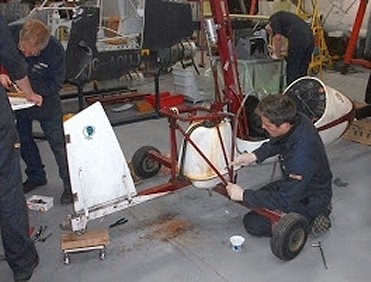 |
On 30th October 2013 a group of MOD apprentices from
Abbey Wood, Filton, on attachment to The Museum for a few days,
were asked to start the preparation of G-AXRA for conservation.
In a very short time they had dismantled the rudder assembly and
removed the Volkswagen engine from its mountings (left). To expedite the work several original technical drawings of the Cricket, which accompanied the gyroplane when donated to The Museum, were first digitised to ensure their preservation. Only about 33 Crickets were produced by Campbell Aircraft Ltd. in 1969/ 70, at a rate of two per week, with single examples exported to France, Denmark, Norway and Malaysia |
|
while six went to Kuwait for shrimp spotting. Selling price in 1970 was around £1645.00 ex-factory. Production ended in 1971 although some kit-builds were produced, subsequently, by Cricket Gyroplanes Ltd. Layzell Gyroplanes Ltd. have also offered self-build replica kits as the 'AV-18', with a Volkswagen or Rotax engine and horizontal stabiliser. |
||
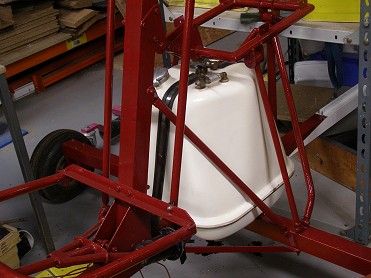 |
In early 2014 the conservation volunteers refurbished the Cricket's steel frame, with its under-seat fuel tank, applying new primer, undercoat and gloss paint in the original colours (left). Rebuild and conservation work continued, at a relaxed pace, until January 2016 when more manpower and time could be devoted to the project (below), allowing G-AXRA to be completed and to go on public display in August 2016. | |
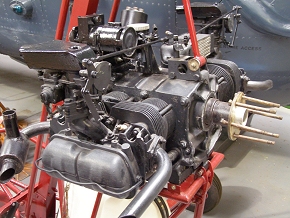 |
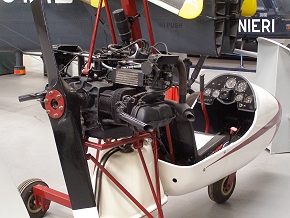 |
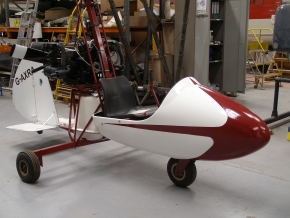 |
||
| Back in May 2014 we received an email from Chris Schnurr,
younger son of Lewis Edward Schnurr, the first registered charterer of G-AXRA, telling us that he had
seen the photographs and description of his father's gyrocopter on this website. He attached a photograph
(right) of
himself sitting at the controls of a gyrocopter, painted as G-AXRA, at the age of five,
probably at Membury, in
1975. The fully-enclosed cockpit looks very different from any Campbell Cricket we have seen and the fin/rudder assembly is also unfamiliar in many ways. Understandably Chris had little detailed memory of the machine but was making enquiries. Of course we would still be grateful to hear from anyone who has memories of G-AXRA, at Membury or elsewhere, in the mid-1970s. |
 |